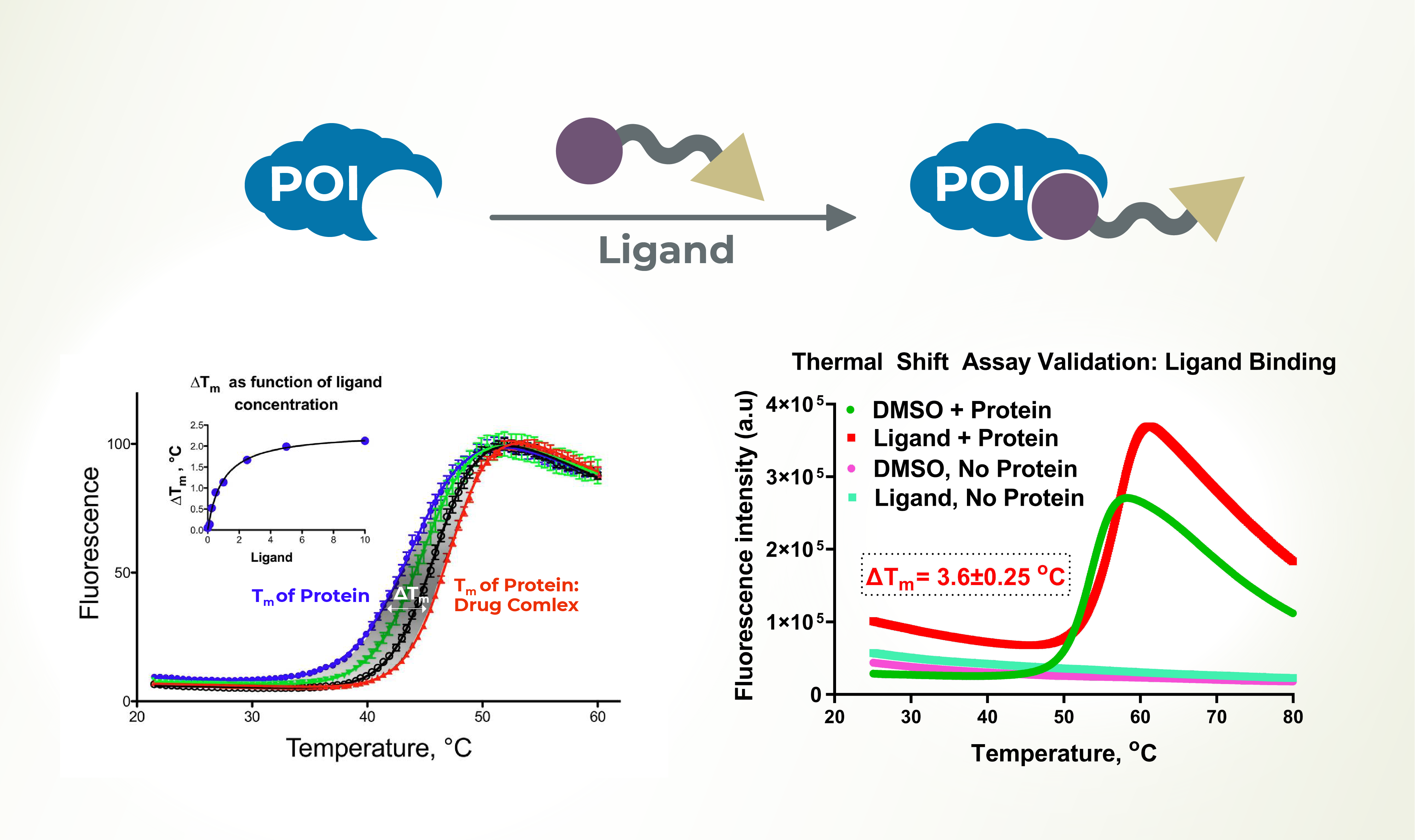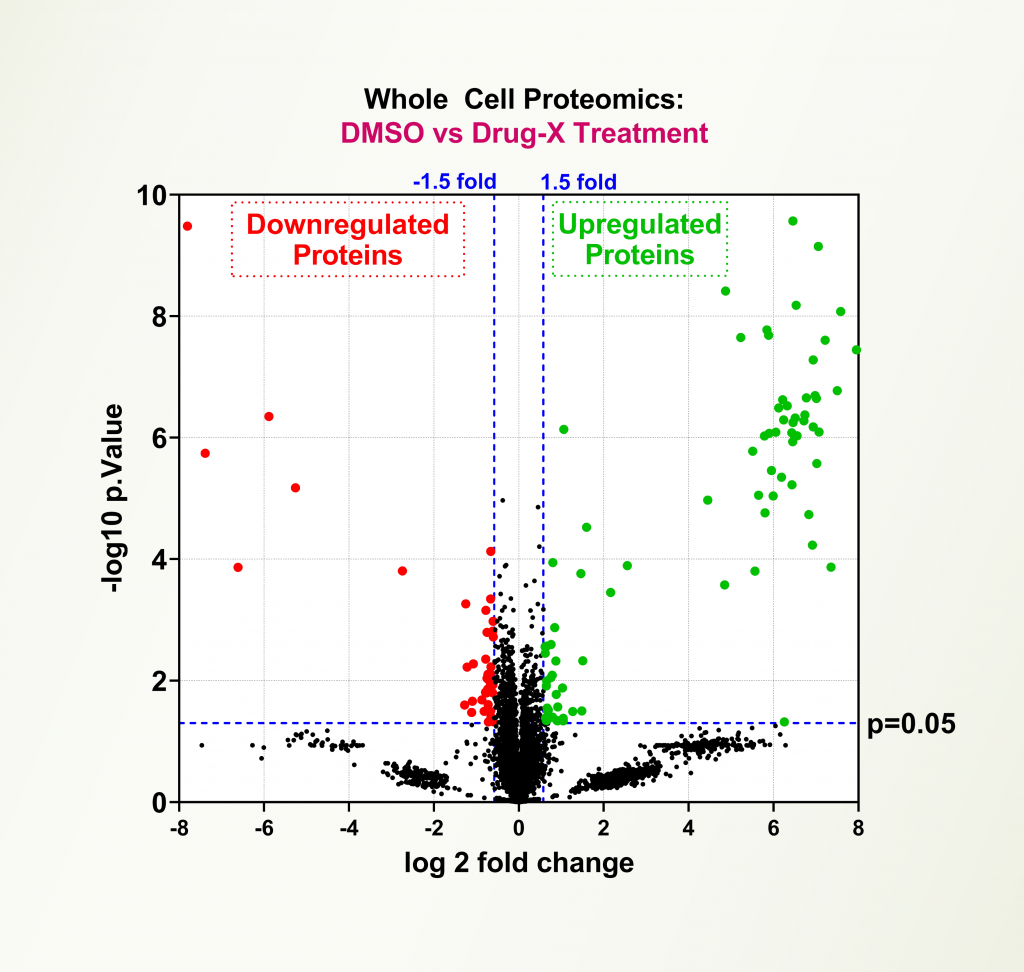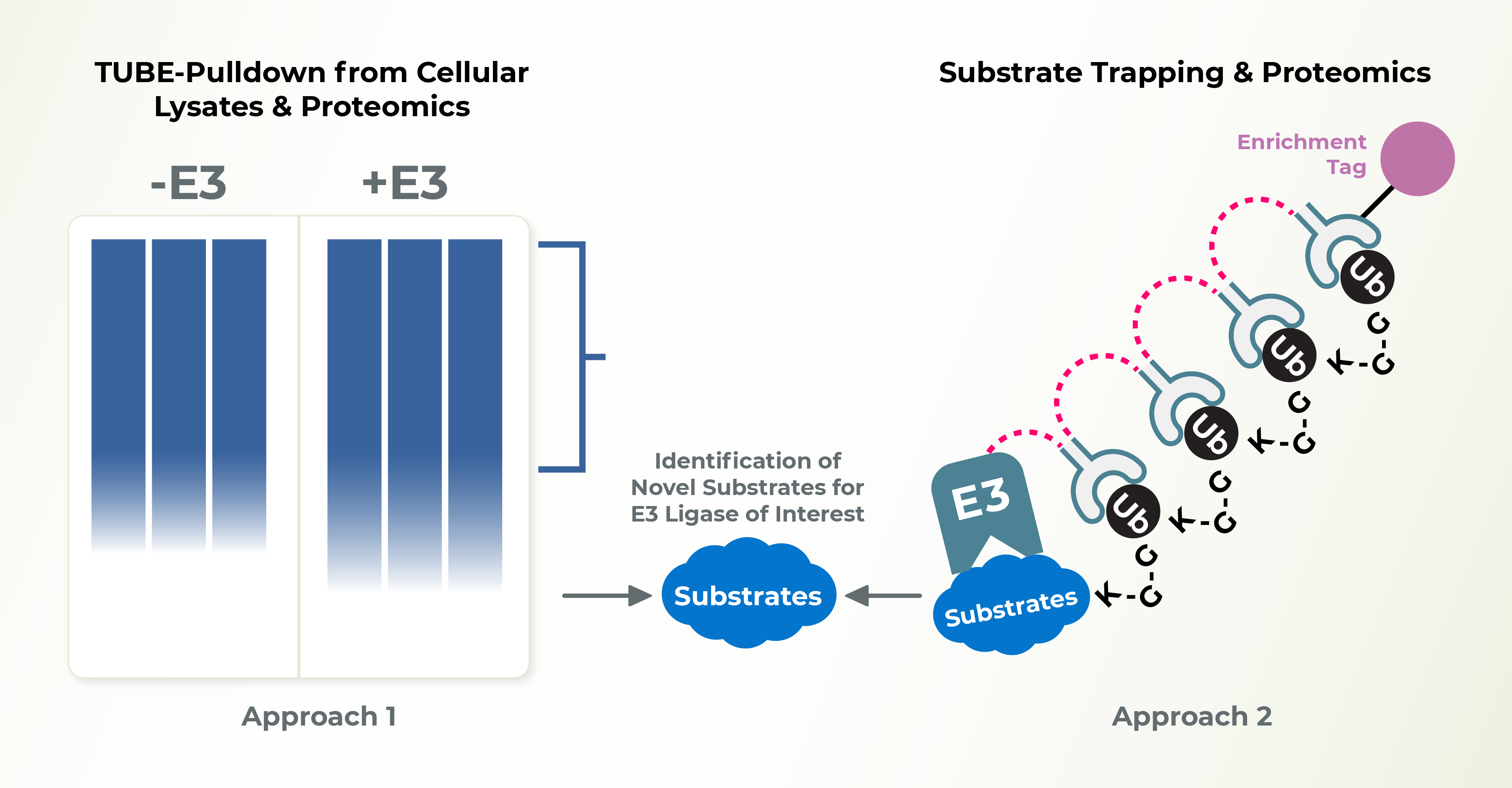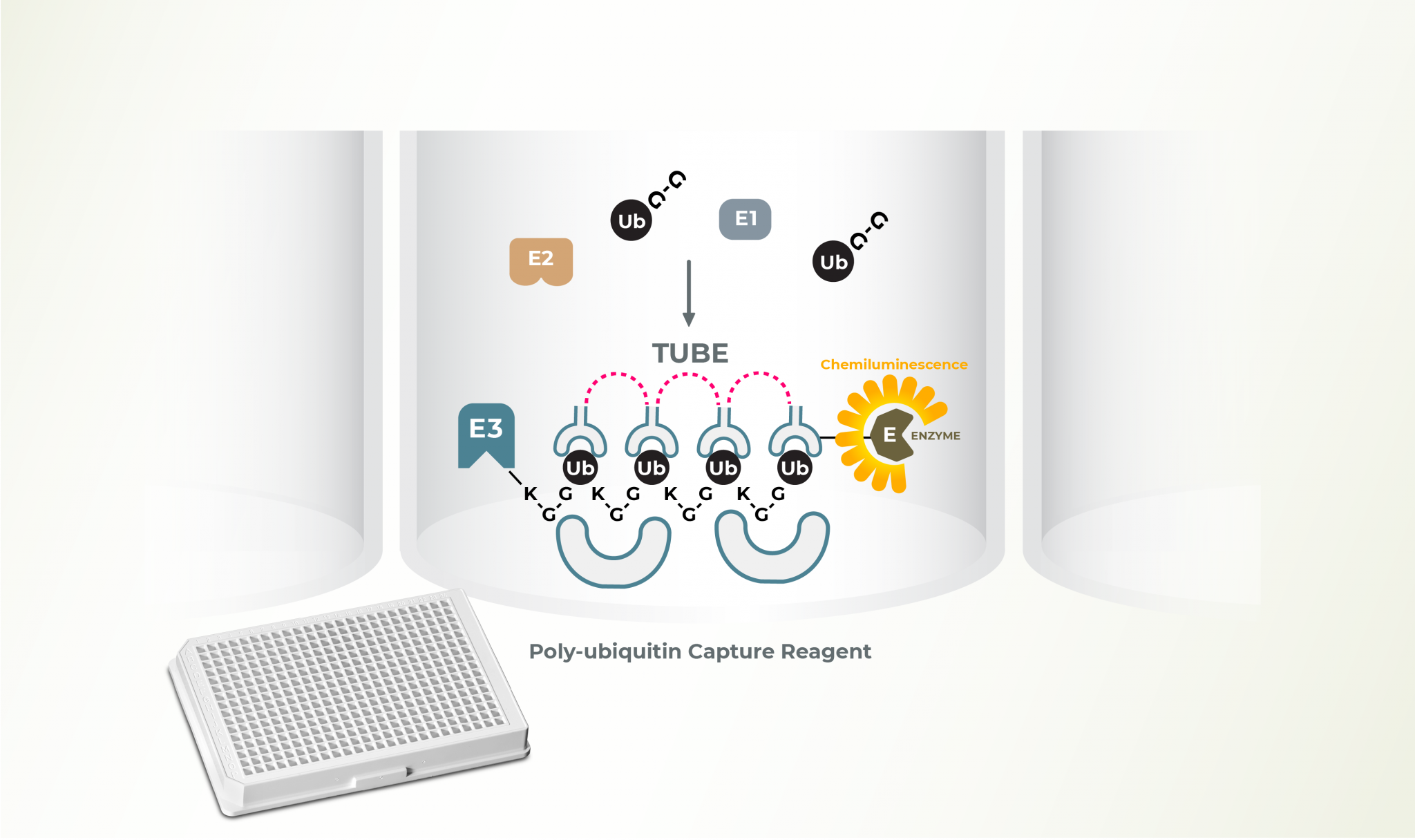E3 Ubiquitin Ligases Profiling & Screening
Advanced reagents and assays for comprehensive E3 ligase screening and profiling solutions
E3 Ubiquitin Ligases Profiling & Screening
At LifeSensors, we have developed reagents and assays encompassing both traditional and non-traditional approaches for E3 ligase screening and profiling. LifeSensors’ small molecule library contains a collection of ligase-centric compounds, which can be employed as a gold standard for your ligase drug discovery efforts. Further, LifeSensors has the tools to quickly exclude off-target hits through a variety of complementary biochemical and biophysical validation assays. In E3 ligase drug discovery, connecting the dots is particularly important.
Quickly distinguishing true hits from false positives, developing structure-activity relationships, and establishing rank order potency from purified enzymes to cellular models are key steps to success. LifeSensors brings together the tools and expertise necessary to overcome the many pitfalls in the E3 ligase field.

Learn More About LifeSensors' E3 Ligase Screening & Profiling Here
E3 Ubiquitin Ligases Profiling & Screening: In Vitro Assays In Vitro Assays

Thermal Shift Assays
Generating experimental data for ligands binding to target proteins of interest as well as determination of ligand binding affinity (Kd) is essential for drug discovery. The thermal shift assay is a quick and easy method to generate ligand-protein binding data, and is widely employed across several target proteins and compounds, including natural products. LifeSensors has established a robust protein thermal shift assay platform and offer services to facilitate ligand discovery and characterization for clients. Together with our proprietary protein expression and purification technology, Lifesensors can help you discover ligands for difficult to express target proteins.
Service Highlights
- Label Free Technology amenable to a HTS
- Independent of catalytic activity
- Characterization of small molecule and PROTACs binding to target proteins
- Facilitates identification of E3 and DUB ligands

Whole Cell Proteomics
Generating experimental data for ligand binding to target protein of interest as well as determination of ligand binding affinity (Kd) is essential for drug discovery. SPR is a label-free optical technique that measures interactions in real time. A target of interest (ligand) is immobilized on a thin gold-coated glass chip while a second molecule (analyte) is flowed over the chip. Changes in the refractive index at the gold surface as the analyte binds to and dissociates from the ligand are monitored to generate sensograms, from which kon, koff, and KD can be calculated.
At LifeSensors we use SPR to study ligand-protein binding for drug discovery by validating hit compounds as a secondary screen. LifeSensors have established a robust protocol to study PROTACs interaction with target and E3 ligase as both binary and ternary complex formation. With over 30 ligases at our disposal, we have optimized conditions to study interaction with novel binders for PROTAC applications.
LifeSensors SPR studies are performed by highly trained technicians with thorough expertise in SPR and broad biophysics knowledge to guide clients in drug discovery of challenging targets. We use BRUKER Sierra SPR- 32 Pro high-through SPR analyzer that can enable 13,200 interactions studies (4400 samples) per day. Their breakthrough SPR+ detector allows for superior sensitivity with signal-to-noise ratio of 0.02 RU derived as a function of imaging SPR (SPRi) and high-speed optical scanning. It is crucial to have best signal-to-noise ratio when screening for identifying and characterizing novel small molecule ligands and PROTAC studies to study binary interactions.
Service Highlights
- Tailored solutions to study protein-protein, protein-small molecules/PROTAC interactions
- Characterization of small molecule and PROTACs binding to E3 and target proteins
- Characterization of E3 and DUB ligands and demonstrate selectivity
- High-throughput screening with kinetics and affinity reporting (kon, koff, and KD)
Read More About Our Ligase Screening & Profiling Here

E3 TR-FRET Biochemical Assay
E3 ligases remain among the most difficult enzyme targets to assay and discover potent therapeutic applications, possibly due to their dependence on upstream E1 and E2 enzymes for the activation and transfer of ubiquitin. As a result, traditional assays for E3 ligases are complex and prone to off-target false positives. At LifeSensors, we have developed reagents and assays encompassing both traditional and non-traditional approaches for E3 ligase screening and profiling. Quickly distinguishing true hits from false positives, developing structure-activity relationships, and establishing rank order potency from purified enzymes to cellular models are key steps to success. LifeSensors brings together the tools and expertise necessary to overcome the many pitfalls in the E3 ligase field.
Our E3 TR-FRET detection system utilizes our TUBE technology to monitor E3 ligase activity by fluorescence signal. This assay involves donor -labeled TUBEs that bind to acceptor-labelled polyubiquitin chains synthesized by the target E3 ligase. When Donor labelled TUBEs come in close proximity to polyubiquitin chains containing acceptor-labeled ubiquitin will yield in a FRET signal. This signal can be monitored over time in a homogenous, high-throughput format, making it ideal for small-molecule screening to find tool compounds for E3 ligases.
Service Highlights
- High throughput screening using compound libraries to discover novel inhibitors/activators/binders for E3 ligases
- Automated liquid handling amenable to large library screening
- Access to ~30 E3 ligases for performing discovery and selectivity studies in rapid homogenous assay format
- Access to customized collection of ligase centric small molecule libraries for using as reference in ligase drug discovery efforts
- Ultrasensitive with robust signal to noise powered by TUBE technology
- Extensive experience in UPS related drug discovery – complementary biochemical and biophysical validation studies to exclude off-target hits
Besides aiding drug-discovery E3 ligase screening and profiling services at LifeSensors also offers identification of E2-paris for E3 ligase of interest, identification of nature of poly-ubiquitination on E3 ligase and protein of interest to gain insights into signaling mechanisms using chain selective TUBE technology.
Learn More About our E3 TR-FRET Assay Here
E3 Ubiquitin Ligases Profiling & Screening: Cell-Based Assays Cell-Based Assays

E3 ELISA Assay
E3 ligases remain among the most difficult enzyme targets to assay and discover potent therapeutic applications, possibly due to their dependence on upstream E1 and E2 enzymes for the activation and transfer of ubiquitin. As a result, traditional catalytic assays for E3 ligases are complex and prone to off-target false positives. At LifeSensors, we have developed reagents and assays encompassing both traditional and non-traditional approaches for E3 ligase screening and profiling. Quickly distinguishing true hits from false positives, developing structure-activity relationships, and establishing rank order potency from purified enzymes to cellular models are key steps to success. LifeSensors brings together the tools and expertise necessary to overcome the many pitfalls in the E3 ligase field.
Our ELISA-based assay is a proven, high throughput method for monitoring E3 ligase activity. It is a perfect low-cost option for small molecule screening. E3 ELISA assay is based on the capture of the polyubiquitinated E3 ligase or the E3’s substrate by a proprietary polyubiquitin binding reagent. Labelled Tandem Ubiquitin Binding Entities (TUBEs) are used to detect the polyubiquitination by chemiluminescence.
Service Highlights
- High throughput screening using compound libraries to discover novel inhibitors/activators/binders for E3 ligases
- Access to ~30 E3 ligases for performing discovery and selectivity studies
- Access to customized collection of ligase centric small molecule libraries for using as reference in ligase drug discovery efforts
- Ultrasensitive with robust signal to noise powered by TUBE technology
- Extensive experience in UPS related drug discovery – complementary biochemical and biophysical validation studies to exclude off-target hits
Besides aiding drug-discovery E3 ligase screening and profiling services at LifeSensors also offers identification of E2-paris for E3 ligase of interest, identification of nature of poly-ubiquitination on E3 ligase and protein of interest to gain insights into signaling mechanisms using chain selective TUBE technology.
Learn More About Our E3 ELISA Assay Here

UbiTest Substrate Validation
LifeSensors’ UbiTest is a medium-throughput platform for measuring the polyubiquitylation levels of protein(s) of interest (POI). UbiTest utilizes TUBE technology to enrich polyubiquitylated proteins. This fraction is analyzed by immunoblotting techniques with and without pan-selective DUB digestion. The appearance or increase in the intensity of the band corresponding to the POI indicates that the POI is polyubiquitylated in the studied condition. Identification of the type of ubiquitin linkage can provide insights into the cellular functions of E3s and substrates.
Service Highlights
- Cell-based assays to measure endogenous substrate ubiquitination.
- Conversion of polyubiquitin smear of the POI to a single band in the DUB-treated fraction simplifies the quantification.
- Overcome the issue of target-specific primary antibody failing to detect ubiquitinated target protein due to epitope masking by the bulky ubiquitin chain.
- Identify the polyubiquitin linkages on the POI by digesting with linkage-specific DUBs.
- Study the effect of PROTACs or small molecules.

